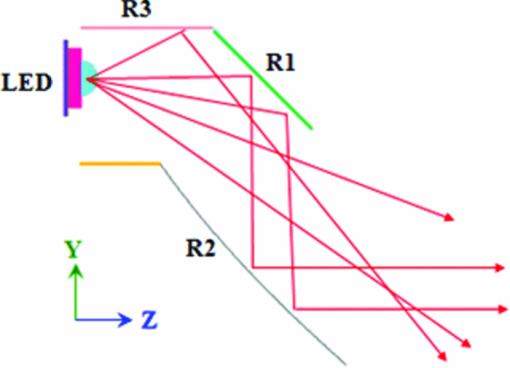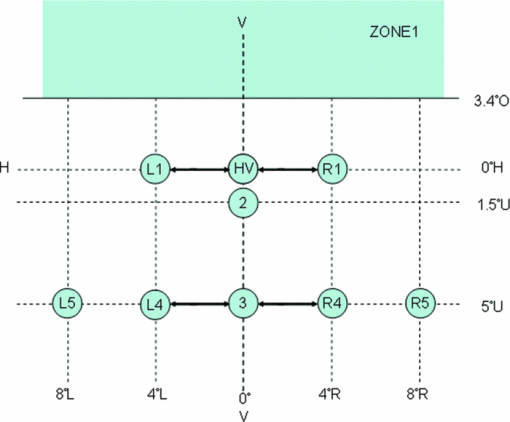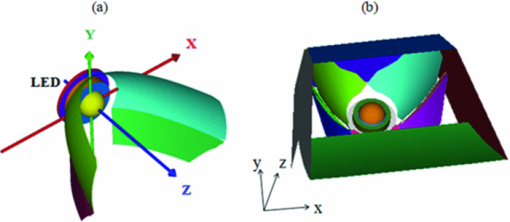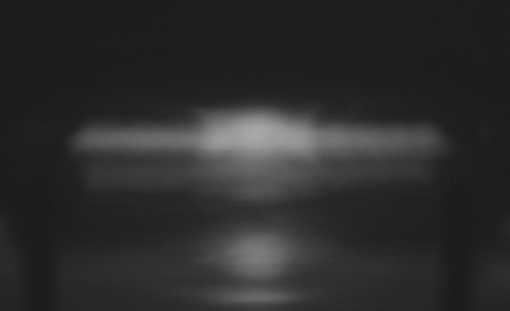|
|
|
Light-emitting diodes (LEDs) have been regarded as the most important light source in the 21th century owing to the advantages of energy saving, long life, fast response, high color performance, and environmental benefit.1, 2 Accordingly, many applications were proposed and demonstrated with use of the new solid state light source in the last decade. Among those applications, vehicle forward lighting demands more optical design capability to meet the regulation for security point.3, 4 The bike headlamps based on LEDs is one of the interesting topics since it requests not only lighting in security but also extreme-low energy consumption. In this letter, we will present a new design to achieve a regulation-based lighting pattern with high optical efficiency. The design starts from choosing an appropriate LED. The barrel in using an LED as the light source is that there is no regular power-LED so that a designer should choose a suitable and commercialized LED. In the study, we select a 1 W based LED made by Cree with number of X-RE-P4, where the measured luminous efficacy was 84 lm/W at the typical injection current of 350 mA. The first task is to develop a precise optical model of the LED. We apply the mid-field model to verify the accuracy of the model.5, 6 The normalized cross-correlation5, 7 of the build model in three mid-field distances, 3, 5, and 7 cm, are all larger than 99.5%, which means that the optical model is ready for precise optical design for a projection lamp. The second task is to develop a high-efficiency secondary optics to enable the illumination pattern to meet the K-mark regulation, where the illumination requirement is shown in Fig. 1. (Refs. 4 and 8). A general approach in projection lamp is to design a total-internal-refraction (TIR) lens.9, 10, 11 In such an application, the volume of the TIR lens will be large and an aspherical surface or microstructure could be implanted on the exit surface to perform the cut-off line and requested pattern. The difficulty in mass production and high cost will make such a design impractical. Another design is to apply a multisegment reflector, where the drawback is low optical efficiency. In this letter, to achieve the contrast requested in the cut-off line, we design a light pipe with two horizontal parallel planar reflectors R3, and with two special slanted surfaces, R1 and R2, as shown in Fig. 2. R3 is used to reflect a part of lights to illuminate the roadway. The best shape for R1 is a planer surface and its tilt angle is about 45 deg from the z axis. The shape about R2 can be parabola or ellipse to provide a narrow light pattern along the y axis. The two slanted reflectors are used to build up a stripe illumination pattern with extreme high contrast. It is, however, the divergent angle in the horizontal direction that is too large to make enough illumination at the HV zone, which is the hot point in the regulation. To overcome this problem, a reflector pair near the LED is added as shown in Fig. 3, which is used to collimate the lights spreading in a horizontal direction. The combined structure is shown in Fig. 3. The size is about 35 × 35 × 45 mm3. The optical efficiency is about 80%. The diameter of the input aperture is about 8 mm and the size of the output aperture is 26 × 27 mm2. The simulated light pattern is shown in Fig. 4, where the illumination at the HV zone is bright enough and the contrast across the cut-off line is high enough to meet the K-mark regulation. After optimization, the contrast across the cut-off line is as high as 250, which is far larger than 5 as requested in the regulation. The contrast is the ratio of the illuminance at HV and the maximum at zone 1. Fig. 2The light pipe containing two horizontal parallel planar reflectors with two special slanted surfaces, R1 and R2.  The experiment was started with fabricating a prototype of the reflector as well as the light pipe. The surfaces of the secondary optics, which were formed by CNC (computer numerical control) machining, were not as smooth as expected so that the effective reflectivity is not as that in the design. Although the sample was not well finished, the lighting pattern as shown in Fig. 5 shows that a similar illumination pattern with a clear cut-off line could be seen. When the LED was driven at a current of 350 mA, the contrast reached 21, but the illumination on the HV zone was only 6.4 lux, which is smaller than 10 lux in the regulation. In such a lamp, the high contrast across the cut-off line is more important than the illumination on the HV zone. The reason is that a high-contrast cut-off line comes from a high-quality design and a low illumination may come from the defects of the fabrication, such as the roughness and the curvature error of the reflective surface from the fabrication. Since the light pattern of the real sample was similar to the design one, and the contrast still met the request in the regulation, we can judge that the design is successful. With increasing the injection current to 700 mA, the illumination was increased to 10.5 lux and the contrast was kept 21. All the check points as described in the regulation passed the K-mark regulation. In summary, a new design for a bike headlamp based on a commercialized high-power white LED is proposed and demonstrated. The design started from building up a precise optical model of the LED. Then a new design containing a horizontal reflector and vertical light pipe with two special reflectors was proposed to achieve a high-contrast pattern with high illumination at the center zone. In the optimized design, the contrast was as high as 250. The mold-up optical elements were formed by CNC with rough surface so that a lower center illumination and a lower contrast across the cut-off line were observed. However, the contrast in the experiment still reached 21, which is higher than 5 as requested in the K-mark regulation. With increasing the injection current to 700 mA, the illumination was increased to 10.5 lux and the contrast was kept at 21. All the check points as described in the regulation passed the K-mark regulation. AcknowledgmentsThe study was sponsored by the National Science Council of the Republic of China with Grant No. NSC100-3113-E-008-001. ReferencesD. A. Steigerwald, J. C. Bhat, D. Collins, R. M. Fletcher, M. O. Holcomb, M. J. Ludowise, P. S. Martin, and S. L. Rudaz,
“Illumination with solid state lighting technology,”
IEEE J. Sel. Top. Signal Process., 8 310
–320
(2002). https://doi.org/10.1109/2944.999186 Google Scholar
A. Zukauskas, M. S. Shur, and R. Caska, Introduction to Solid-State Lighting, Wiley & Sons, New York
(2002). Google Scholar
C. C. Sun, T. X. Lee, S. H. Ma, Y. L. Lee, and S. M Huang,
“Precise optical modeling for LED lighting verified by cross correlation in the midfield region,”
Opt. Lett., 31 2193
–2195
(2006). https://doi.org/10.1364/OL.31.002193 Google Scholar
I. Moreno and C. C. Sun,
“Modeling the radiation pattern of LEDs,”
Opt. Express, 16 1808
–1819
(2008). https://doi.org/10.1364/OE.16.001808 Google Scholar
W. T. Chien, C. C. Sun, and I. Moreno,
“Precise optical model of multi-chip white LEDs,”
Opt. Express, 15 7572
–7577
(2007). https://doi.org/10.1364/OE.15.007572 Google Scholar
L. Sun, S. Jin, and S. Cen,
“Free-form microlens for illumination applictions,”
Appl. Opt., 48 5520
–5527
(2009). https://doi.org/10.1364/AO.48.005520 Google Scholar
J. Y. Joo, C. S. Kang, S. S. Park, and S. K. Lee,
“LED beam shaping lens based on the near-field illumination,”
Opt. Express, 17 23449
–23458
(2009). https://doi.org/10.1364/OE.17.023449 Google Scholar
Z. Zheng, X. Hao, and X. Liu,
“Freeform surface lens for LED uniform illumination,”
Appl. Opt., 48 6627
–6634
(2009). https://doi.org/10.1364/AO.48.006627 Google Scholar
|





